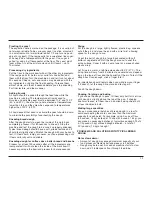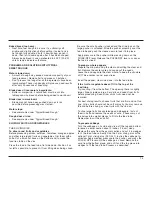
If motor speeds up, continue processing. If not, add more
flour – 1 tablespoon at a time – until motor speeds up.
Process until dough cleans side of work bowl.
Blade doesn’t incorporate ingredients:
•
Always start processor before adding liquid. Add liquid in
slow, steady stream, only as fast as dry ingredients absorb
it. If you hear liquid sloshing, stop adding it but do not turn
off machine. Instead, wait until ingredients in work bowl
have mixed, then add remaining liquid slowly. Pour liquid
onto dough as it passes under feed tube opening; do not
pour liquid directly onto bottom of work bowl.
Blade rises in work bowl:
•
Blade may not have been pushed down as far as possible
before processing was started.
Dough doesn’t clean inside of work bowl:
•
Amount of dough may exceed maximum capacity of your
food processor. Remove half and process in 2 batches
.
•
Dough may be too dry. If it feels crumbly, add water –
1 tablespoon at a time – while machine is running, until
dough becomes moist and cleans inside of work bowl. Wait
10 seconds between additions of water.
•
Dough may be too wet. While machine is running, add
1 tablespoon of flour. If necessary, add more – 1 tablespoon
at a time – until dough cleans inside of work bowl.
•
Plastic dough blade is intended only for recipes calling for at
least 3-1/2 cups of flour (17-1/2 ounces, 495 g). If your
recipe calls for less flour, remove plastic dough blade and
insert metal blade. Always use metal blade for recipes
calling for less than 3
1
⁄
2
cups of flour (17-1/2 ounces, 495 g).
Nub of dough forms on top of blade and does not
become uniformly kneaded:
•
Stop machine, carefully remove dough, divide it into
3 pieces and redistribute them evenly in work bowl.
Continue processing until dough is uniformly soft and
pliable.
Dough feels tough after kneading:
•
Divide dough into 2 or 3 pieces and redistribute evenly in
bowl. Process 10 seconds or until uniformly soft and pliable.
Soft dough or liquid leaks onto base of food processor:
•
Always start processor before adding liquid and add
liquid only as dry ingredients absorb it.
Dough is too dry:
• While machine is running, add water – 1 tablespoon at
a time – until dough is sufficiently moist to clean inside
of bowl.
Dough is too wet and sticky:
• While machine is running, add 2 tablespoons of flour and
process 10 seconds. If necessary, add more flour – 1 table-
spoon at a time – waiting 10 seconds after each addition,
until dough cleans inside of bowl.
Motor stops:
•
Pusher assembly may have become unlocked. Push down
pusher sleeve to lock it into place and continue processing.
•
Cover may have become unlocked. Lock cover and contin-
ue processing.
•
Power cord may have become unplugged. Plug in machine
and continue processing.
•
Excessive strain may have caused motor to overheat and
stop. Wait for motor to cool off, divide dough into 2 batches,
and complete processing.
Dough doesn’t rise:
•
We recommend that you always test activity of yeast before
using it by stirring it and at least 1/2 teaspoon sugar into
about 1/3 cup (80ml) warm liquid 105°F to 120°F (40° to
49°C). Within 10 minutes foam should develop, indicating
yeast is active. Do not use dry yeast after expiration date
on package.
•
Avoid killing yeast cells by dissolving yeast in too warm
water or overheating dough by excessive kneading.
Dissolve yeast in about 1/3 cup (80ml) warm water at
105° to 120°F (40° to 49°C). All other liquid should be cold.
•
Let dough rise in draft-free environment of about 80° to
90°F (26° to 32°C). (For most predictable environment, use
oven that has been turned on briefly to lowest temperature,
then turned off before placing dough in it. Cushion bottom of
bowl with pot holder or towel.)
•
Dough containing whole grain flour will take longer to rise
than dough made of white flour only.
13
Summary of Contents for DLC XP - DLC-X Plus Food Processor
Page 1: ...DLC XP Food Processor ...
Page 51: ......















































